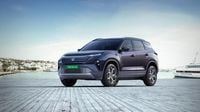Tata Motors has emerged as a leader in India’s electric passenger vehicle (ePV) segment, with strategies that are proving effective in the growing competitive landscape. While many automobile manufacturers are still betting on hybrid and compressed natural gas (CNG) technologies, Tata's decisive shift towards electric mobility has positioned it at the forefront of the market. The company launched its Nexon.eV, based on its internal combustion engine (ICE) model, maintaining a familiar design for consumers while delivering an innovative interior experience. This strategic approach has led to the Nexon.eV becoming the highest-selling passenger EV in India.
Before the Nexon was launched, Tata Motors gained valuable insights from adapting the Tigor.eV for the Energy Efficiency Services Limited (EESL) order back in 2017. Leveraging this experience, Tata introduced the Tiago.eV at an accessible price of ₹7.99 lakh, democratizing access to electric vehicles for a broader consumer base. As the demand for EVs grew, Tata launched the Punch.eV in early 2024, utilizing the advanced acti.ev architecture, a modular electric vehicle platform designed for scalability and efficiency.
The success of Tata’s innovative line of electric vehicles continues with the anticipated releases of new models including the Harrier.eV and the Sierra.eV, which were showcased at the 2023 Auto Expo and the 2024 Bharat Mobility Expo, with expected launches in the first and second halves of 2025, respectively. The latest addition, the Curvv.eV SUV Coupe, features a sleek design and boasts a claimed range of 400–425 km, effectively addressing price parity issues with traditional ICE vehicles. The Curvv.eV’s market positioning is aimed at bringing consumers an affordable yet high-performing electric vehicle.
Since the initiation of its electric vehicle offerings in 2020, Tata Motors has seen tremendous growth, starting with just 1,200 passenger EVs sold in FY 2020. The following fiscal year saw sales increase to 4,200 units, while FY 2022 recorded 19,000 units sold. A significant milestone was reached in FY 2023 when total sales surpassed 50,000 units, reflecting a remarkable growth of 154%. The upward trend continued in FY 2024, with Tata selling 82,000 EVs—a 64% increase over the previous year. While FY 2025 figures are still being compiled, Tata has reported 23,000 units of Curvv.eV sold so far.
At present, over 200,000 Tata EVs are operating nationwide, collectively having covered more than 5 billion kilometers. Between April 2024 and February 2025, a total of 94,696 electric passenger vehicles were sold, marking a 16% rise compared to 81,549 units sold in the same period the previous year. Market statistics indicate Tata.eV currently holds a commanding 56% market share, with its nearest competitor, JSW MG Motor India, trailing at 27% as of March 22, 2025.
The electric vehicle industry in India has undergone a dramatic transformation over the past few years. From less than 170,000 vehicles sold in FY 2020, the total sales jumped to more than 1.67 million units in FY 2024—a staggering increase of 865%. Projections indicate that sales in FY 2025 will exceed 2 million units, pushing the EV segment into a new growth trajectory. This success is largely attributed to various factors including improved vehicle charging infrastructure, competitive pricing, diminished range anxiety for consumers, and the growing consumer awareness regarding environmental issues.
Tata Motors' foresight in imprinting a solid electric vehicle strategy is evident in their successful product launches and well-defined pricing strategies. As the market continues to develop, Tata's commitment to developing accessible and efficient products is poised to strengthen its leadership position in electric mobility in India.

